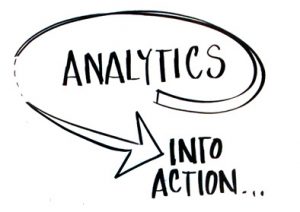 We live in a "microwave society." We want it hot, and we want it now. This is true for business decision-making as well as food.
We live in a "microwave society." We want it hot, and we want it now. This is true for business decision-making as well as food.
But how do we improve our time to decision? When we look at the process of decision-making, the key "ingredient" is analytics. Analytics take data and turn it into useful information.
The anatomy of any analytics application follows this flow:
- Operational data flows through a data acquisition/credibility component to determine what data is relevant to solving the problem.
- The relevant data is then analyzed and turned into useful information.
- The useful information is then visualized and consumed to provide insight.
- Insight is acted upon for decision making.
Again, every analytics application follows this process flow, whether the problem is within or spans any of the five advanced analytical categories: statistics, data mining, forecasting, text, or optimization.
You can also look at the process flow like this:
Raw Data -> Acquired/Cleansed -> Relevant Data -> Analyzed/Transformed -> Useful Information -> Visualized/Consumed -> Action
These "buckets" are composed of two elements - storage and software:
Storage -> Software -> Storage -> Software -> Storage -> Software -> You
Focusing on the software, there are three main software steps - or, more often manifested, SILOS highlighted:
- Acquired/Cleansed: I call this the pre-text.
- Analyzed/Transformed: I call this the context.
- Visualized/Consumed: I call this the Post-text.
Let's start in the middle, the context. Analytics - taking data and turning it into information. Did you know that turning data into information can take a LOOOOONG time? SAS technology can help improve this process. I can tell you abut a company that had 40 million customer records being scored in less than 4 minutes, where the organization was scoring 350,000 records in 30 minutes. I can talk about a process that was running in 167 hours and now is running in less than 2 minutes. I can talk about decreasing the process to derive insight from two weeks to four days (and I will below). The context - analytics - is relevant data transformed to insight significantly faster. I know you see the value in having more current information. We make better decisions with more current insights. And we all want to make better decisions.
But, we have to consider the pre-text: Data acquisition/credibility - acquiring the right data needed for the problem. Recently, I attended a high-performance computing conference where an individual aptly described the impact of new breakthroughs in technology. He stated that, in time past, he would take relevant data and his analytical program, go to the computer lab, load it all up, and start running the program. He would put a piece of paper over the monitor that said "DO NOT TOUCH - RUNNING ANALYTICS," and then go away and pray the power wouldn't go off for two weeks. Two weeks from data to insight. But now, with the advent of high-performance computing, the same analysis runs in 5 hours! The context - analytics - relevant data to insight improved from two weeks to 5 hours. Impressive. He followed that statement with - but it took me a year to create the relevant data. So - did he go from 2 weeks to 5 hours, or from 54 weeks to 52 weeks (and change)?
To really make an impact on decision-making, we need to consider (and streamline) the acquisition, the pre-text.
How about the post-text, or the consumption of analytics? Again, recently I was working with a customer on streamlining their analytic lifecycle. Their process to build analytic models and then deploy those models took two weeks. In a "prove-it-to-me" scenario, by leveraging SAS technology and doing some process re-engineering, I was able to show the organization that their process could be streamlined to four days. The context - Analytics - relevant data to insight improved from 10 business days to 4 business days. Impressive. The customer replied in effect, that's great, but we're not going to adopt the technology or the newly re-engineered process. WHY? Because this department's downstream internal customers could not consume the information within their current two week turnaround! If information came sooner than expected, analytical models would be "sitting on the shelf."
To really make an impact on decision-making, we need to consider (and streamline) the consumption, the post-text.
The stories above are two examples of impacting the CONTEXT, of turning data into insight, that had negligible effect on truly affecting time-to-decision. You want to change the way you do business? Make sure you consider and streamline the pre-text of data acquisition and the post-text of visualization and consumption. Not just the context of transforming data to insight.
By the way, SAS can help you with the pre-text. SAS can help you with the post-text. And, of course, SAS can help you with the context.
